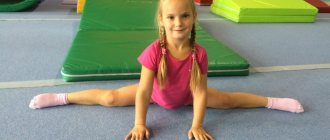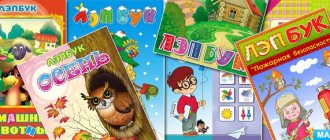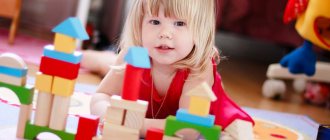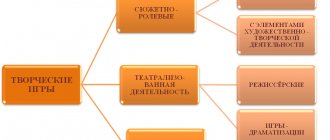Basic principles of massage
- You can start massage and gymnastics only when the child reaches 1.5 - 2 months of age.
- It is better to practice daily, setting a certain time for this and trying to stick to it.
- You need to start a massage for a newborn 30-40 minutes after feeding, end 20-30 minutes before meals, and only if the child is in a calm state and in a good mood.
- For the first lessons, 5 - 6 minutes will be enough, gradually increase the time to 10 - 15 minutes. The optimal duration of massage for an “experienced” baby after six months is 30 minutes.
- The massage is carried out in a ventilated room at a temperature not lower than 20 °C.
- It is best to conduct classes on a changing table or any other flat surface covered with a small oilcloth and a diaper. The surface should be wide enough to easily turn the baby over.
- Before the massage, the baby should be clean, the mother’s hands should be clean, dry, warm and with trimmed nails. It is better not to use talcum powder or petroleum jelly, as they clog the pores of the baby's skin. To avoid damaging delicate baby skin, rings, watches and bracelets must be removed.
- During the massage, try not to make sudden movements or raise your voice. In order for both you and your baby to enjoy themselves, and for the activities to be beneficial, the environment should be calm.
- Try to keep your child in a good mood during classes. Hold it confidently, but very carefully, without allowing any violence. You should especially protect your head from shocks and bruises. If the child is restless and crying, pause and do not start again until he calms down.
- Movements when performing a massage are directed along the blood vessels: strictly from bottom to top, from the periphery to the center. The liver area should be bypassed when massaging the abdomen. Also, the inner thighs, the child’s genitals and elbows are not massaged. When massaging your back, you should not use shock techniques (patting, tapping) in the kidney area.
- Contraindications to the use of massage for babies: acute febrile conditions, various infectious diseases, severe forms of rickets, extensive inguinal, femoral and umbilical hernias, congenital heart disease, severe blood diseases, malignant tumors (before their radical treatment), diseases accompanied by brittle bones and pain in them, acute tuberculosis, digestive disorders, as well as various inflammatory skin diseases.
Combine business with pleasure! While you are doing massage and gymnastics, read poems, nursery rhymes, and sing songs to your baby. Name parts of the body, objects that fall into the child’s field of vision, comment on your actions - this way you are also engaged in speech development.
Complex 4. From 6 to 9 months. Improving coordination of movements
At the age of 6–9 months, the baby must be taught to crawl correctly, coordinating the movements of the arms and legs for this purpose. In gymnastics and massage, the focus of attention from the arms and legs moves to the chest, back and abdomen, and the massage of these areas becomes more energetic.
- Crossing arms (6 – 8 times).
- Exercises for legs: simultaneous extension and bending of legs (4 – 6 times); alternate extension and bending of the legs (4 – 6 times with each leg).
- Turns on your stomach.
- Massage of the buttocks and back.
- Crawling on all fours.
- Abdominal massage.
- Squats with spine bending (1 – 2 times).
- Circular movements with your arms (4 – 6 times).
- Foot massage.
- Raising straight legs (6 – 8 times).
- Lifting from a prone position (1 – 2 times).
- Breast massage.
- Squat with support from bent arms (1 – 2 times).
- Boxing exercise (5-6 times with each hand).
- Exercise "wheelbarrow".
Option 2
— We received a new letter from Pilyulkin, with drawings. He tells us that guys, we also have “magic points” on our bodies that will also help us cope with Queen Cold and Princess Bad Mood. Let's look at these drawings and find these points from each other (children look at the drawings together, in pairs they study the points on a friend's body, on their own body). By gently massaging each point ten times every day, we will become strong and resilient. But remember, it is important that your touches are gentle and pleasant to your friend, only then the “magic points” work.
Formation of moral health of preschool children: Activities, games, exercises / Ed. L. V. Kuznetsova, M. A. Panfilova. - M.: TC Sfera, 2003. - 64 p. pp. 19-22.
What are the benefits of massage?
It is difficult to overestimate the wonderful qualities of even an ordinary healing massage for children. And therapeutic massage for infants generally works wonders. It can eliminate problems such as hip dysplasia, congenital hip dislocation, clubfoot and flat feet, inguinal and umbilical hernia, rickets, scoliosis, postural defects, hypertonicity and hypotonicity, spastic and muscular torticollis. Of course, such a massage is performed only according to indications and must be performed by a certified specialist.
What is the secret of massage? The fact is that impulses coming from the skin along the nerve pathways reach the cerebral cortex and have a tonic effect on the central nervous system. This improves its control over the work of all organs and systems:
- Improves the functioning of the cardiovascular system, enhances blood and lymph circulation;
- Strengthens the digestive system, normalizes the functioning of the gastrointestinal tract, which promotes weight gain;
- Trains the respiratory system;
- Strengthens the excretory function of the glands;
- Strengthens the musculoskeletal system - increases the elasticity of muscle fibers and overall muscle performance; strengthens the ligaments of the joints, increases the range of their movements;
- Improves sleep quality;
- Helps with body awareness;
- Improves skin condition, increases its resistance to external influences;
- It affects the peripheral and central nervous system and has a calming effect.
But the main advantage of massage for babies is that it has a positive effect on the relationship between mother and child: affection, tenderness, mutual understanding and acceptance between them increases.






